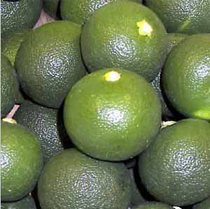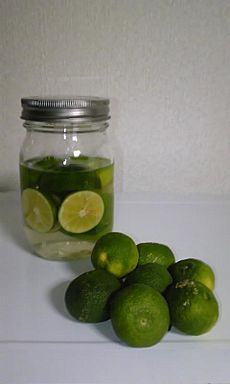Sudachi facts for kids
Quick facts for kids Sudachi |
|
|---|---|

Sudachi fruits
|
|
| Genus | Citrus |
| Species | C. sudachi |
Sudachi (Citrus sudachi; Japanese: スダチ or 酢橘) is a small, round, green fruit from the citrus family. It comes from Japan and is a special product of Tokushima Prefecture. Sudachi is a sour citrus fruit, so people don't usually eat it on its own. Instead, they use its juice to add flavor to food, much like you would use lemon or lime juice. Scientists have studied its genes and found that sudachi is a mix of a yuzu fruit and another citrus fruit, similar to koji or tachibana orange.
What is Sudachi?
Sudachi has been grown in parts of Japan for hundreds of years. It's almost as well known as the yuzu fruit there. People often say it's a "must-have" when eating matsutake mushrooms. A special Japanese sauce called ponzu uses sudachi juice. This sauce is a tangy alternative to vinegar and often includes juices from other sour citrus fruits like kabosu or daidai.
Tokushima Prefecture is very famous for sudachi. About 98% of all sudachi fruits in Japan come from this area. The towns of Kamiyama-cho and Sanagouchi-son produce almost half of Tokushima's sudachi each year.
How Sudachi Grows
The sudachi plant has white flowers that bloom in May and June. The fruits grow in tight bunches. Farmers usually pick them in the fall. Even though sudachi fruits will eventually turn yellow-orange, they are almost always picked and used while they are still green. Inside, they have large, smooth seeds.
How People Use Sudachi
Since sudachi is very sour, people don't eat the whole fruit. Instead, they squeeze it like a lemon or lime to add flavor to their meals. You might see a half-slice of sudachi served with many traditional Japanese dishes. This includes fish, soba noodles, udon noodles, and even some drinks.
Sudachi is thought to have a stronger, more exciting flavor and smell than lemons or limes. It also has more calcium and vitamin C than lemons. In Japan, especially in Tokushima Prefecture, you can find many products flavored with sudachi. These include ice cream, vodka coolers, ice pops, and soft drinks. In other parts of Japan, fresh sudachi fruit can be quite expensive because it's seen as a special treat. Sudachi fruits are smaller than a similar citrus called kabosu. A sudachi usually weighs about 20 to 40 grams, while a kabosu is much larger, weighing 100 to 140 grams.
Some farms in California and Peru have also started growing sudachi. This began around 2008 when the trees became easier for nurseries to get.
Sudachi and Your Health
Sudachi contains special natural substances called flavonoids. These are also found in lemons and limes. Some of these substances are antioxidants, which means they can help protect your body's cells. They are also thought to help block things that can cause allergies.
Another substance in sudachi, called narirutin, is known to help with pollen allergies. Sudachi juice has about three times more narirutin than yuzu juice. This substance is also found a lot in the skin of yuzu and kabosu fruits.
Scientists have also looked into how sudachi might help your body absorb calcium. This is important for strong bones.
In 2006, a research team from Tokushima University studied sudachi. They suggested that the fruit might help lower glucose (sugar) levels in people with diabetes. The team gave sudachi zest to rats for a year. They found that the rats' glucose levels went down, and the rats showed signs of better health.
See also
 In Spanish: Citrus sudachi para niños
In Spanish: Citrus sudachi para niños


